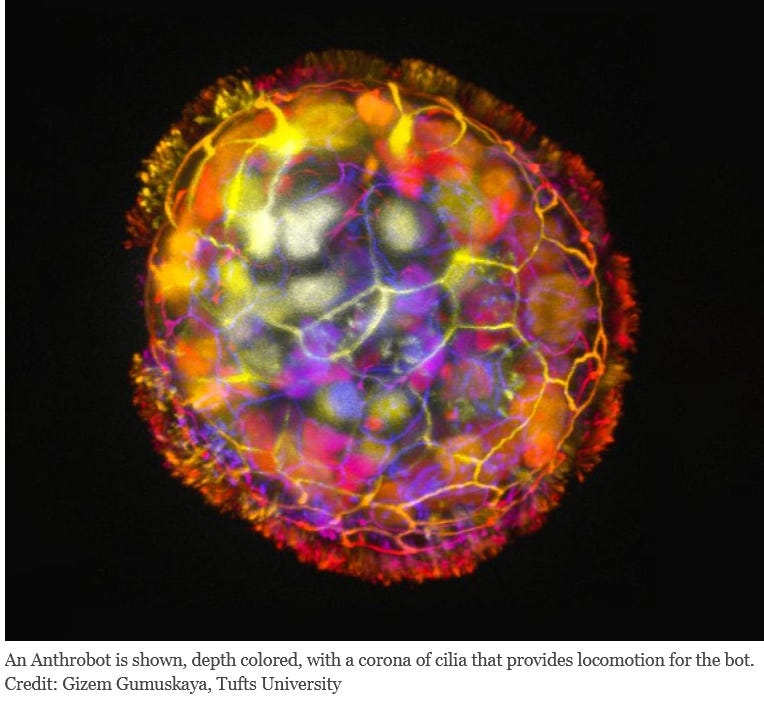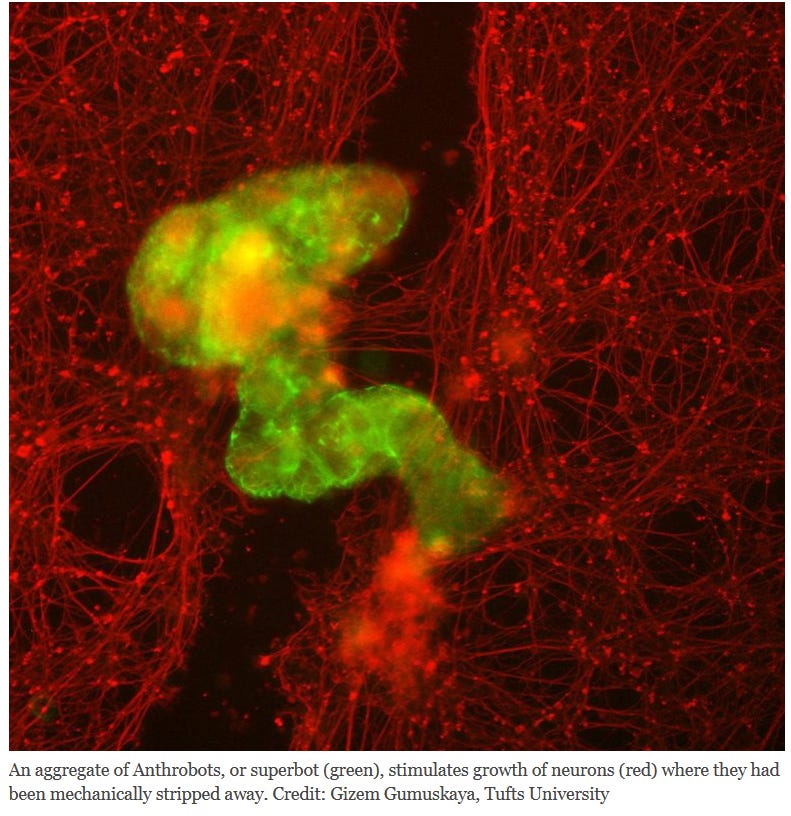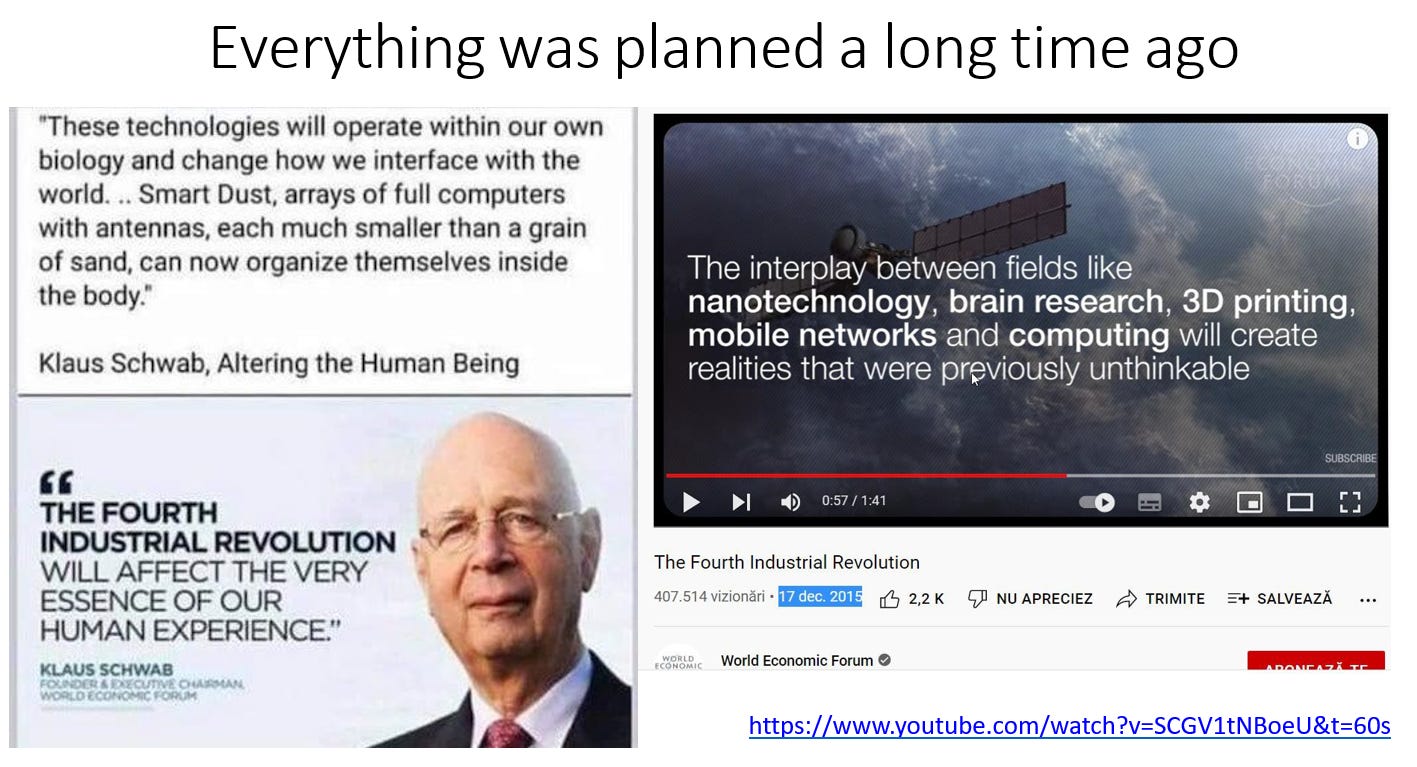…The Worlds Self Replicating Living Robots And The Next Phase: Self Assembly HUMAN ANTHROBOTS
Many people have difficulty accepting the concept of self replicating nanotechnology, nano robotics and artificial life. However, this field of science is rapidly evolving and has been featured in recent years even in mainstream media. Self replication or reproduction has been achieved – which makes these synthetic robotic organisms created and controlled by Artificial Intelligence a life form. Note everything that I have been reporting is confirmed here in this CNN article. The robots WORK TOGETHER INTELLIGENTLY AND SELF HEAL.
What could go wrong when robots decide by themselves to self replicate? Well uncontrolled self replication of nanotechnology is considered one of the ways that we could have an extinction level event on earth according to Dr Louis A Del Monte, Author of the book “Nanoweapons – A Growing Threat To Humanity”.
Please note that the research was partially funded by the Defense Advanced Research Projects Agency ( DARPA), a federal agency that oversees the development of technology for military use. So is there any risk for dual purpose application when the military studies self replicating robots which can build endless clones of themselves? What useful work can they be programmed to do – how about destroy the host organism over time or on command, would that be possible?
The original study was published here:
Kinematic self-replication in reconfigurable organisms
Almost all organisms replicate by growing and then shedding offspring. Some molecules also replicate, but by moving rather than growing: They find and combine building blocks into self-copies. Here we show that clusters of cells, if freed from a developing organism, can similarly find and combine loose cells into clusters that look and move like they do, and that this ability does not have to be specifically evolved or introduced by genetic manipulation. Finally, we show that artificial intelligence can design clusters that replicate better, and perform useful work as they do so. This suggests that future technologies may, with little outside guidance, become more useful as they spread…
Their discussion suggests that Artificial Intelligence remains in control of the robots and is able to postpone loss of replication. In days it can develop new qualities of artificial life.
We find that synthetic multicellular assemblies can also replicate kinematically by moving and compressing dissociated cells in their environment into functional self-copies. This form of perpetuation, previously unseen in any organism, arises spontaneously over days rather than evolving over millennia. We also show how artificial intelligence methods can design assemblies that postpone loss of replicative ability and perform useful work as a side effect of replication. This suggests other unique and useful phenotypes can be rapidly reached from wild-type organisms without selection or genetic engineering, thereby broadening our understanding of the conditions under which replication arises, phenotypic plasticity, and how useful replicative machines may be realized.

Spontaneous kinematic self-replication. (A) Stem cells are removed from early-stage frog blastula, dissociated, and placed in a saline solution, where they cohere into spheres containing ∼3,000 cells. The spheres develop cilia on their outer surfaces after 3 d. When the resulting mature swarm is placed amid ∼60,000 dissociated stem cells in a 60-mm-diameter circular dish (B), their collective motion pushes some cells together into piles (C and D), which, if sufficiently large (at least 50 cells), develop into ciliated offspring (E) themselves capable of swimming, and, if provided additional dissociated stem cells (F), build additional offspring. In short, progenitors (p) build offspring (o), which then become progenitors. This process can be disrupted by withholding additional dissociated cells. Under these, the currently best known environmental conditions, the system naturally self-replicates for a maximum of two rounds before halting. The probability of halting (α) or replicating( 1 − α) depends on a temperature range suitable for frog embryos, the concentration of dissociated cells, the number and stochastic behavior of the mature organisms, the viscosity of the solution, the geometry of the dish’s surface, and the possibility of contamination. (Scale bars, 500 μm.)
Does this look at all familiar to you? It does to me. Here you can see a C19 unvaccinated individual’s Darkfield Live Blood Analysis with millions of nano and micro robots building a hydrogel mesogen and transforming the blood into a rubbery clot – absolutely coordinated work:
Please check out the CNN article with multiple videos”:
World’s first living robots can now reproduce, scientists say
Formed from the stem cells of the African clawed frog (Xenopus laevis) from which it takes its name, xenobots are less than a millimeter (0.04 inches) wide. The tiny blobs were first unveiled in 2020 after experiments showed that they could move, work together in groups and self-heal.
Now the scientists that developed them at the University of Vermont, Tufts University and Harvard University’s Wyss Institute for Biologically Inspired Engineering said they have discovered an entirely new form of biological reproduction different from any animal or plant known to science.
“I was astounded by it,” said Michael Levin, a professor of biology and director of the Allen Discovery Center at Tufts University who was co-lead author of the new research.
“Frogs have a way of reproducing that they normally use but when you … liberate (the cells) from the rest of the embryo and you give them a chance to figure out how to be in a new environment, not only do they figure out a new way to move, but they also figure out apparently a new way to reproduce.”
“Most people think of robots as made of metals and ceramics but it’s not so much what a robot is made from but what it does, which is act on its own on behalf of people,” said Josh Bongard, a computer science professor and robotics expert at the University of Vermont and lead author of the study.
“In that way it’s a robot but it’s also clearly an organism made from genetically unmodified frog cell.”
Bongard said they found that the xenobots, which were initially sphere-shaped and made from around 3,000 cells, could replicate. But it happened rarely and only in specific circumstances. The xenobots used “kinetic replication” – a process that is known to occur at the molecular level but has never been observed before at the scale of whole cells or organisms, Bongard said.
What is the next phase of this? Human Anthrobots. Please look at this full article from December 2023 with its videos and images:
Medical Marvel: Human Cells Transformed Into Tiny Biological Robots

Researchers at Tufts University and Harvard University’s Wyss Institute have created tiny biological robots that they call Anthrobots from human tracheal cells that can move across a surface and have been found to encourage the growth of neurons across a region of damage in a lab dish.
The multicellular robots, ranging in size from the width of a human hair to the point of a sharpened pencil, were made to self-assemble and shown to have a remarkable healing effect on other cells. The discovery is a starting point for the researchers’ vision to use patient-derived biobots as new therapeutic tools for regeneration, healing, and treatment of disease.

This robot stimulates neuron growth, meaning it modifies the brain. Again this is described for therapeutic uses, but the dual use is evident. You can 3 D print via these robots anything, hence the hospital in your body as I have written about previously:

Gumuskaya explained that cells have the innate ability to self-assemble into larger structures in certain fundamental ways. “The cells can form layers, fold, make spheres, sort and separate themselves by type, fuse together, or even move,” Gumuskaya said. “Two important differences from inanimate bricks are that cells can communicate with each other and create these structures dynamically, and each cell is programmed with many functions, like movement, secretion of molecules, detection of signals and more. We are just figuring out how to combine these elements to create new biological body plans and functions—different than those found in nature.” Taking advantage of the inherently flexible rules of cellular assembly helps the scientists construct the bots, but it can also help them understand how natural body plans assemble, how the genome and environment work together to create tissues, organs, and limbs, and how to restore them with regenerative treatments.
Summary:
Biotechnology, nanotechnology, bionanorobotics, Artificial Intelligence biotech interface, brain computer interface, bioengineering of artificial life is so far advanced, that most people have difficulty comprehending the magnitude of the developments happening. However, we must learn to survive. I recently saw a post in a prominent physician group that my research is “Quackery. “
These poor doctors have no idea how far behind the current knowledge they are and how much we all need to study to understand the threats that we are facing as humanity. If all you read is JAMA and NEJM you will be lost in the conversation about these biotechnological advances, the threat they pose and the discovery of solutions. I am not personally offended by these attacks but saddened when the hope of supposed freedom doctors remain so closed minded. It does not give me much hope that people will awaken to this before it is too late, which it possibly already could be now, given the worsening findings in human blood around the world. We cannot see nanobots in brain tissue – how do you know that a parallel AI processing platform has not already been installed in the C19 injected? I believe it has.
The global biotechnology market was valued at USD 1.55 trillion in 2023 and is projected to grow at a compound annual growth rate (CAGR) of 13.96% from 2024 to 2030.
You cannot wish this away. The fusion of AI with humanity is here. It is happening silently, just as Klaus Schwab has said. If you want to even start to fight for the survival of the human species, and our soul and spirit, you must learn about the weapons that the enemy is using.

